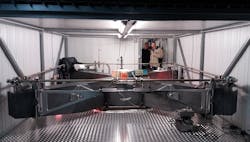Ring laser gyroscope array measures deep-Earth effects
Detailed in AIP's Review of Scientific Instruments, Italian researchers hope to measure Earth's rotation using a laser-based gyroscope housed deep underground, with enough experimental precision to reveal measurable effects of Einstein’s general theory of relativity. The scientists say that the ring laser gyroscope (RLG) technology enabling these Earth-based measurements provides, unlike those made by referencing celestial objects, inertial rotation information, revealing fluctuations in the rotation rate from the grounded reference frame.
RELATED ARTICLE: Light-powered gyroscope has sub-millimeter dimensions
A group from the Italian National Institute for Nuclear Physics' (INFN) Laboratori Nazionali del Gran Sasso (LNGS) are working with a research program aimed at measuring the gyroscopic precession Earth undergoes due to a relativistic effect called the Lense-Thirring effect. This program, called Gyroscopes in General Relativity (GINGER), would eventually use an array of such highly sensitive RLGS. For now, they have successfully demonstrated its prototype, GINGERino, and acquired a host of additional seismic measurements necessary in their efforts.
In the journal, the group reports successful installation of the single-axis GINGERino instrument inside the INFN's subterranean laboratory LNGS, and its ability to detect local ground rotational motion. Ultimately, GINGER aims to measure Earth's rotation rate vector with a relative accuracy of better than one part per billion to see the miniscule Lense-Thirring effects.
"This effect is detectable as a small difference between the Earth’s rotation rate value measured by a ground based observatory, and the value measured in an inertial reference frame," said Jacopo Belfi, lead author and a researcher working for the Pisa section of INFN. "This small difference is generated by the Earth’s mass and angular momentum and has been foreseen by Einstein's general theory of relativity. From the experimental point of view, one needs to measure the Earth rotation rate vector with a relative accuracy better than one part per billion, corresponding to an absolute rotation rate resolution of 10-14 [radians per second]."
The underground placement of these systems is essential for getting far enough away from external disturbances from hydrology, temperature or barometric pressure changes to carry out these types of sensitive measurements. This pilot prototype is expected to reveal unique information about geophysics, but, according to Belfi, "underground installations of large RLGs, free of surface disturbances, may also provide useful information about geodesy, the branch of science dealing with the shape and area of Earth."
"RLGs are essentially active optical interferometers in ring configuration," Belfi said. "Our interferometers are typically made of three or four mirrors that form a closed loop for two optical beams counter propagating along the loop. Due to the Sagnac effect, a ring interferometer is an extremely accurate angular velocity detector. It's essentially a gyroscope."
The group's approach enabled the first deep underground installation of an ultrasensitive large-frame RLG capable of measuring the Earth’s rotation rate with a maximum resolution of 30 picorads/second.
"One peculiarity of the GINGERino installation is that it's intentionally located within a high seismicity area of central Italy," Belfi said. "Unlike other large RLG installations, GINGERino can actually explore the seismic rotations induced by nearby earthquakes." GINGERino is now operating, along with seismic equipment provided by the Italian Institute of Geophysics and Volcanology, as a rotational seismic observatory. "GINGERino and one co-located broadband seismometer make it possible to retrieve, via a single station, information about the seismic surface wave's phase velocity that in standard seismology requires using large arrays of seismometers," said Belfi.
SOURCE: American Institute of Physics (AIP); http://www.alphagalileo.org/ViewItem.aspx?ItemId=173369&CultureCode=en
About the Author

Gail Overton
Senior Editor (2004-2020)
Gail has more than 30 years of engineering, marketing, product management, and editorial experience in the photonics and optical communications industry. Before joining the staff at Laser Focus World in 2004, she held many product management and product marketing roles in the fiber-optics industry, most notably at Hughes (El Segundo, CA), GTE Labs (Waltham, MA), Corning (Corning, NY), Photon Kinetics (Beaverton, OR), and Newport Corporation (Irvine, CA). During her marketing career, Gail published articles in WDM Solutions and Sensors magazine and traveled internationally to conduct product and sales training. Gail received her BS degree in physics, with an emphasis in optics, from San Diego State University in San Diego, CA in May 1986.
